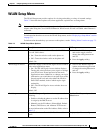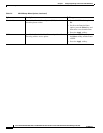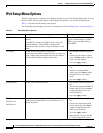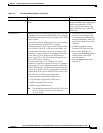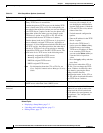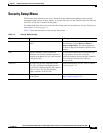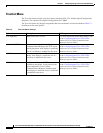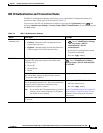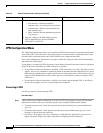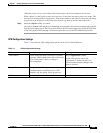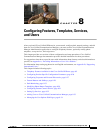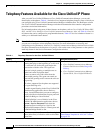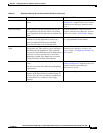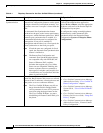
7-15
Cisco Unified IP Phone 8961, 9951, and 9971 Administration Guide for Cisco Unified Communications Manager 8.5 (SIP)
OL-20861-01
Chapter 7 Configuring Settings on the Cisco Unified IP Phone
Security Setup Menu
802.1X Authentication and Transaction Status
The 802.1X Authentication Settings menu allows you to enable 802.1X authentication and view
transaction status. These options are described in Table 7-6.
You can access the 802.1X Authentication settings by pressing the Applications button and
choosing Administrator Settings > Security Setup > 802.1X Authentication. To exit this menu, press
the Exit softkey
Table 7-6 802.1X Authentication Settings
Option Description To Change
Device
Authentication
Determines whether 802.1X authentication is enabled:
• Enabled—Phone uses 802.1X authentication to
request network access.
• Disabled—Default setting in which the phone uses
CDP to acquire VLAN and network access.
1. After pressing the Applications button
, choose Administrator Settings
> Security Setup > 802.1X
Authentication > Device
Authentication.
2. Set the Device Authentication option
to Enabled or Disabled.
3. Press the Apply softkey.
EAP-MD5 Specifies a password for use with 802.1X authentication
using the following menu options (described in the
following rows):
• Device ID
• Shared Secret
• Realm
After pressing the Applications button
, choose Administrator Settings >
Security Setup > 802.1X Authentication
> EAP-MD5.
Device ID—Derivative of the phone’s model number
and unique MAC address displayed in this format:
CP-<model>-SEP-<MAC>
Display only—Cannot configure.
Shared Secret—Choose a password to use on the phone
and on the authentication server. The password must be
between 6 and 32 characters, consisting of any
combination of numbers or letters.
Note If you disable 802.1X authentication or perform
a factory reset (reset all settings) of the phone,
the shared secret is deleted.
1. Choose EAP-MD5 > Shared Secret.
2. Enter the shared secret.
3. Press the Apply softkey.
See the “Troubleshooting Cisco Unified IP
Phone Security” section on page 12-9 for
assistance in recovering from a deleted
shared secret.
Realm—Indicates the user network domain, always set
as Network.
Display only—Cannot configure.



